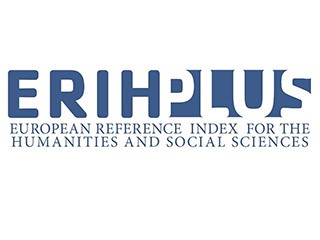
Tourism is one of the most important economic sectors in the last decades. It has been growing for a long period, during which a number of new types of destinations has been attracted by its efervescensy and by the positive effects of tourism on the development of various countries and regions. Societies and economies around the world have been increasingly eager to adopt sustainable principles and practices, and tourism, in this context, as a dinamic economic sector, has benefited from the discovery of new resources which could lay the foundation for further growth. Thus, nature-based tourism is now of greater interest, especially since it is a significant component of sustainable development, through its contribution to the innovative and responsible use of existing natural resources. The present study highlights the role of cultural values of different countries which are currently developing their ecotourism sector, from the perspective of the World Value Survey model, showing that societies where tolerance, receptiveness, autonomy, involvement in decision-making processes, civic responsibility and even religious faith are the foundation for the prevailing set of values, the necessary conditions for the development of this type of tourism are to be found as well.
- Type: Review Article
- Published on: 15th March, 2022
- Keywords: Tourism; Tourism based on nature; Values; Sustainability;
- Pages: 7-15
- Received: 5th January, 2022
- Final revision and acceptance: 14th March, 2022
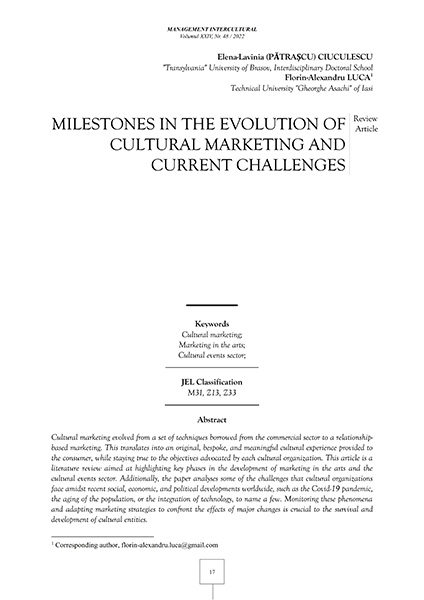
Cultural marketing evolved from a set of techniques borrowed from the commercial sector to a relationship-based marketing. This translates into an original, bespoke, and meaningful cultural experience provided to the consumer, while staying true to the objectives advocated by each cultural organization. This article is a literature review aimed at highlighting key phases in the development of marketing in the arts and the cultural events sector. Additionally, the paper analyses some of the challenges that cultural organizations face amidst recent social, economic, and political developments worldwide, such as the Covid-19 pandemic, the aging of the population, or the integration of technology, to name a few. Monitoring these phenomena and adapting marketing strategies to confront the effects of major changes is crucial to the survival and development of cultural entities.
- Type: Review Article
- Published on: 15th March, 2022
- Keywords: Cultural marketing; Marketing in the arts; Cultural events sector;
- Pages: 17-23
- Received: 4th February, 2022
- Final revision and acceptance: 14th March, 2022

Carious teeth impair the quality of life and the dental and general health of the child. In addition to tooth eruption, tooth position and enamel formation desorders, children can suffer from pain, eating and language problems and have an increased risk of caries in the permanent set of teeth.
- Type: Case Study
- Published on: 28th March, 2022
- Keywords: Dental caries; Prevention;
- Pages: 25-30
- Received: 8th February, 2022
- Final revision and acceptance: 27th March, 2022
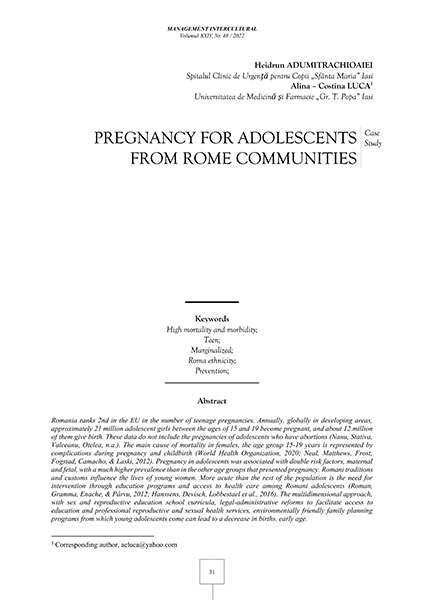
Romania ranks 2nd in the EU in the number of teenage pregnancies. Annually, globally in developing areas, approximately 21 million adolescent girls between the ages of 15 and 19 become pregnant, and about 12 million of them give birth. These data do not include the pregnancies of adolescents who have abortions (Nanu, Stativa, Valceanu, Otelea, n.a.). The main cause of mortality in females, the age group 15-19 years is represented by complications during pregnancy and childbirth (World Health Organization, 2020; Neal, Matthews, Frost, Fogstad, Camacho, & Laski, 2012). Pregnancy in adolescents was associated with double risk factors, maternal and fetal, with a much higher prevalence than in the other age groups that presented pregnancy. Romani traditions and customs influence the lives of young women. More acute than the rest of the population is the need for intervention through education programs and access to health care among Romani adolescents (Roman, Gramma, Enache, & Pârvu, 2012; Hanssens, Devisch, Lobbestael et al., 2016). The multidimensional approach, with sex and reproductive education school curricula, legal-administrative reforms to facilitate access to education and professional reproductive and sexual health services, environmentally friendly family planning programs from which young adolescents come can lead to a decrease in births. early age.
- Type: Case Study
- Published on: 22nd April, 2022
- Keywords: High mortality and morbidity; Teen; Marginalized; Roma ethnicity; Prevention;
- Pages: 31-34
- Received: 18th March, 2022
- Final revision and acceptance: 20th April, 2022

The nature of work is certainly changing, but from a historical perspective this is not new. The rate of change is faster today, and change is the rule not just an exception over time. This paper shows that an Internet-based business model is becoming more common, and this does not mean the end of organizational employment relationships, but supports the need for greater flexibility of jobs and workers. The study of work and employment, as well as the variability of wider environmental and contextual changes in the nature of paid work and employment relations, are relevant to the functioning of a modern economy. Providing an overview of key trends can help to understand the nature of labor relations in the modern economy. The paper presents examples of both change and continuity in the field of work relations.
- Type: Case Study
- Published on: 22nd June, 2022
- Keywords: Work relations; Work environment; Workforce diversity;
- Pages: 35-41
- Received: 21st May, 2022
- Final revision and acceptance: 21st June, 2022
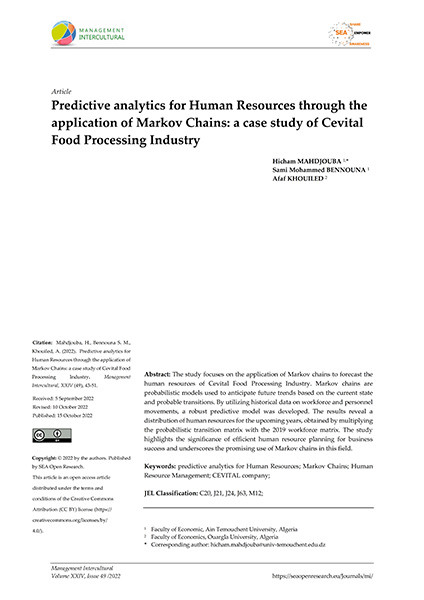
The study focuses on the application of Markov chains to forecast the human resources of Cevital Food Processing Industry. Markov chains are probabilistic models used to anticipate future trends based on the current state and probable transitions. By utilizing historical data on workforce and personnel movements, a robust predictive model was developed. The results reveal a distribution of human resources for the upcoming years, obtained by multiplying the probabilistic transition matrix with the 2019 workforce matrix. The study highlights the significance of efficient human resource planning for business success and underscores the promising use of Markov chains in this field.
- Citation: Mahdjouba, H., Bennouna S. M., Khouiled, A. (2022). Predictive analytics for Human Resources through the application of Markov Chains: a case study of Cevital Food Processing Industry. Management Intercultural, XXIV (49), 43-51.
- Published on: 15th October, 2022
- Keywords: predictive analytics for Human Resources; Markov Chains; Human Resource Management; CEVITAL company;
- Pages: 53-58
- Received: 5th September, 2022
- Final revision and acceptance: 10th Octomber, 2022
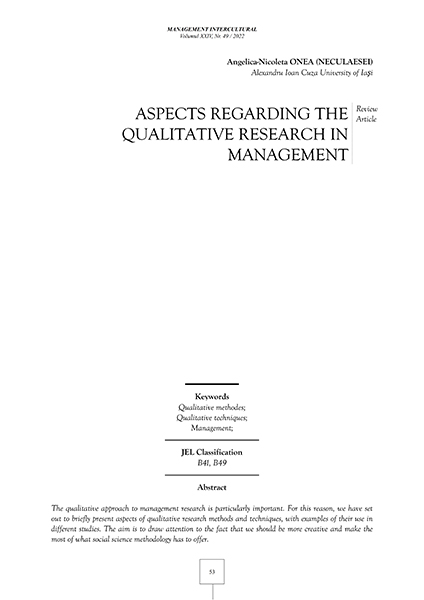
The qualitative approach to management research is particularly important. For this reason, we have set out to briefly present aspects of qualitative research methods and techniques, with examples of their use in different studies. The aim is to draw attention to the fact that we should be more creative and make the most of what social science methodology has to offer.
- Citation: Onea, A. N. (2022). Aspects regarding the qualitative research in management. Management Intercultural, XXIV (49), 53-58.
- Published on: 7th September, 2022
- Keywords: Qualitative methodes; Qualitative techniques; Management;
- Pages: 53-58
- Received: 07th July, 2022
- Final revision and acceptance: 6th September, 2022
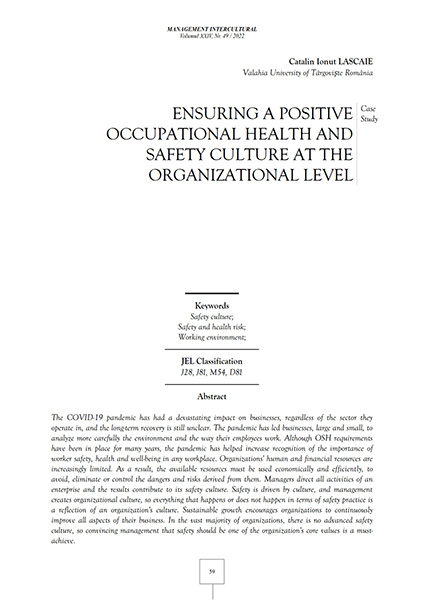
The COVID-19 pandemic has had a devastating impact on businesses, regardless of the sector they operate in, and the long-term recovery is still unclear. The pandemic has led businesses, large and small, to analyze more carefully the environment and the way their employees work. Although OSH requirements have been in place for many years, the pandemic has helped increase recognition of the importance of worker safety, health and well-being in any workplace. Organizations' human and financial resources are increasingly limited. As a result, the available resources must be used economically and efficiently, to avoid, eliminate or control the dangers and risks derived from them. Managers direct all activities of an enterprise and the results contribute to its safety culture. Safety is driven by culture, and management creates organizational culture, so everything that happens or does not happen in terms of safety practice is a reflection of an organization's culture. Sustainable growth encourages organizations to continuously improve all aspects of their business. In the vast majority of organizations, there is no advanced safety culture, so convincing management that safety should be one of the organization's core values is a must-achieve.
- Citation: Lăscaie, C. I. (2022). Ensuring a positive occupational health and safety culture at the organisational level. Management Intercultural, XXIV (49), 59-63.
- Published on: 7th September, 2022
- Keywords: Safety culture; Safety and health risk; Working environment;
- Pages: 59-63
- Received: 10th August, 2022
- Final revision and acceptance: 6th September, 2022



